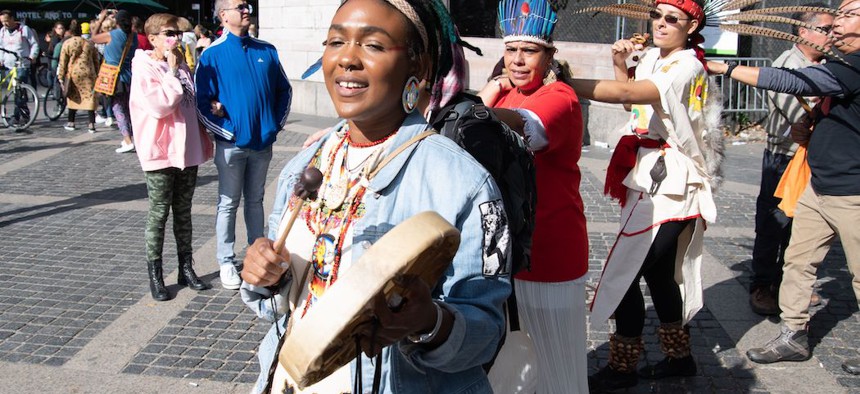New York State
NY’s Indigenous rights bolstered by Supreme Court ruling
The state may be forced to contend with broader land rights and sovereignty for Native American tribes.

People from New York's Indigenous nations gather at Columbus Circle to call for its renaming and honor Indigenous peoples in the Americans in 2019. M Stan Reaves/Shutterstock
A recent landmark U.S. Supreme Court ruling could empower New York’s Indigenous nations. On July 9, the court ruled that most of eastern Oklahoma falls within the Muscogee (Creek) Nation’s land as previous congressionally ratified treaties between the Muscogee and the U.S. government have stated. That precedent could mean land rights claims made by New York’s several Indigenous nations, based on treaties with the federal government, could hold more weight in future disputes between the tribes and the state.
The case originated after Jimcy McGirt, a member of the Seminole Nation in Oklahoma, was convicted of sex crimes, which occurred within the Muscogee Nation’s reservation. McGirt argued in a lawsuit that he could not be prosecuted by the state or local law enforcement and that he could only be prosecuted by the federal government because Congress had never eradicated the Muscogee Nation’s sovereignty.
The case then went to the Supreme Court, which was put to the task of determining whether Congress’ treaty with the Indigenous nation still remained valid.
Justice Neil M. Gorsuch, who is known for siding with Indigenous tribes in past cases despite being a conservative appointed by President Donald Trump, was a part of the majority who ruled in favor of making the federal government stand by its original treaty between Congress and Oklahoma’s Native American tribes. “Today we are asked whether the land these treaties promised remains an Indian reservation for purposes of federal criminal law,” Gorsuch wrote in the Supreme Court’s majority opinion. “Because Congress has not said otherwise, we hold the government to its word.”
McGirt’s conviction was vacated at the state-level but he can still be tried in tribal or federal court.
The case is very similar to that of the Indigenous nations in New York, in which land granted by the federal government was slowly chipped away over time by the state, local governments and non-Indigenous private citizens, through sales that were often allegedly coerced.
The court’s ruling also affirms that state treaties made with Indigenous populations cannot be dismissed just because a state deems them to be too old. “This decision in many ways, simply follows the laws that the U.S. Supreme Court had already established,” Joel Williams, an attorney for the Native American Rights Fund and a citizen of the Cherokee Nation, told City & State.
This has the potential to change the balance of power in land rights disputes between New York state and the Indigenous Six Nation Confederacy in New York, which includes the Mohawk, Oneida, Onondaga, Cayuga, Seneca, and Tuscarora tribes. “(Gorsuch’s) general construct throughout the case was that once the federal government has made promises and treaties, it must keep them,” Joe Heath, general counsel for the Onondaga Nation, told NY1. “I can tell you that, in the almost four decades since I have worked for the Onondaga, that has not been the law.”
In 1794, the Treaty of Canandaigua, which was signed by then-President George Washington, gave the Oneidas 300,000 acres of land in Central New York and their “free use and enjoyment” of it. However, the state continually purchased the Oneida’s land, until the tribe only had 32 acres left in 1920.
In 1997 and 1998, the Oneida purchased land in the town of Sherrill, which was within the original land allocated to the nation, and refused to pay taxes for that reason. The town of Sherrill and the Oneida entered into a dispute over whether or not the treaty still holds up, which would have kept the Oneida from paying the town’s local taxes. In 2005, the Supreme Court sided with Sherrill, denying the nation any sovereignty. In 2013, a similar argument was also rejected by the Supreme Court after the Onondaga Nation claimed that 11 counties within the state, including Syracuse, were illegally stolen from the tribe after it had been given the land in the late 1700s.
As recently as last year, the Seneca Nation has been battling with the state over land rights issues regarding the state’s I-90 thruway. The tribe has maintained since 1993 that the state never received proper approval to build the thruway in 1954. In an effort to protest the state’s refusal to pay millions of dollars in what the tribe considers unpaid tolls, the Senecas prevented New York from repairing the thruway but eventually allowed it to mend the broken roadway.
Heath told City and State that the Onondaga aren’t interested in returning to the courts to argue over land but are hoping this latest decision creates the opportunity for a fruitful discussion between the state and the nation over issues, such as the restoration of the polluted Onondaga Lake. “The Onondaga are much more in favor of diplomacy,” Heath said. “Can we now sit down with the state of New York and work together to resolve these ancient problems? That's what I am asking the (Onondaga’s) Council to authorize me to do and I've already had some preliminary discussions with the attorney general's office.”
The nation would also be interested in speaking with Gov. Andrew Cuomo as well, according to Heath, but has found him to be particularly dismissive of Indigenous issues, noting he has failed to meet with any of the six nations’ traditional chiefs since he’s been in office. “Every other governor would have met with a chief at least once a year, to maintain an open line of communication ... we would be glad to have a conversation with anybody in the state government that wants to work together to end this problem,” Heath said. The governor’s office did not respond to a request for comment.

NEXT STORY: State Legislature meets to act on coronavirus-related bills